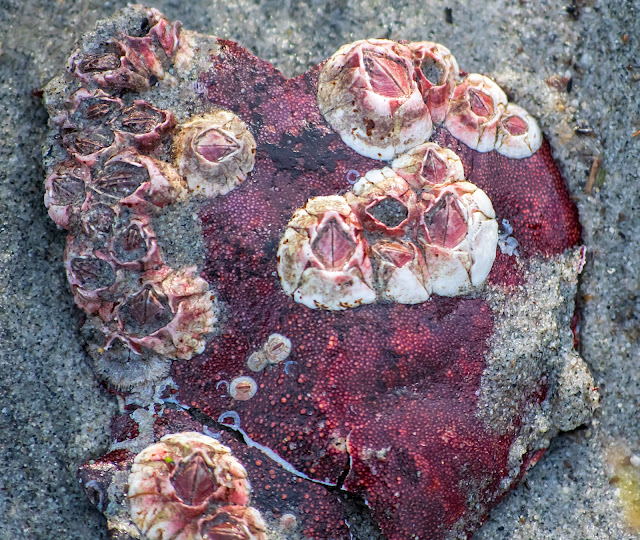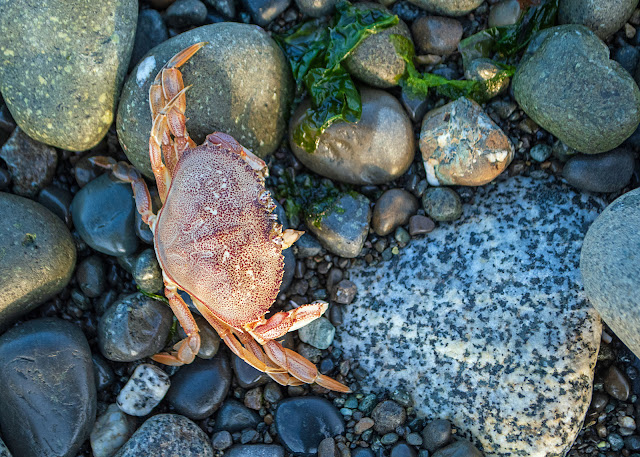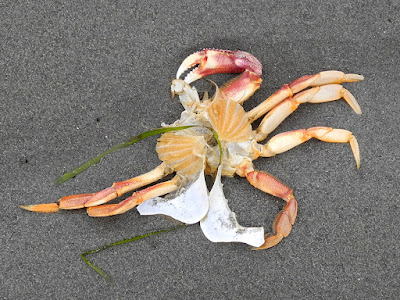All day Sunday it rained, sometimes in buckets. That's three solid days, much appreciated. And a good time to stay inside and watch my crabs.
Just crabs
 |
| "Patch" |
These shore crabs are babies still, some so small I hadn't even seen them until this week. I have discovered some, long ago, as small as a sand grain, unseen until they scuttled sideways in an entirely un-sandlike way. The largest of the half-dozen in the aquarium now, Patch, is maybe half an inch across the carapace.
Small or not, they are feisty. Often they sit by the glass, watching me as I watch them. If I aim a finger their way, they lift warning claws; "I'm going to pinch you!"
Patch was by the glass wall, facing me, as usual. But when I approached him, he made no move. Even a finger on the glass by his face made no impression. Odd.
Three hours later, I stopped by again. Now he had his back to the glass, and lying beside him was his old molted shell. No wonder he wasn't interested in anything else; he had urgent business to attend to. The shell was an obvious size smaller than he is now.
I lightened up the photo to make him more visible. Even so, his camouflage is perfect against the sand. Once he'd hardened up, he buried himself so that only his eyes - two sand grains among thousands - showed up.
(The lines at the bottom of the photo in the sand against the glass are worm tunnels. There are at least two different species of worms there, still only visible with a lens. They'll grow.)
 |
| A smaller cousin, with his latest building project |
Even the tiniest of the crabs, a white-topped cutie about an eighth of an inch across, is a hard worker. Mostly, they're digging new quarters under stones or shells. I watch them backing down the holes, then crawling back up, pushing a load of sand with their pincers. (Tiny Tim - "TT" - moves a grain or two of sand at a time.) The pile is pushed up and far enough away so it won't slide back, and the crab goes back for the next load. Sometimes they surface carrying a stone or a shell in both pincers. Once I saw a crab carry up a snail larger than himself, holding it high overhead until he was on neutral territory, then giving it a good toss. "And stay out!"
In the photo above, the green crab is clearing out a burrow under the stone on the left. The oyster shell on the right is half-buried in the sand, standing on edge, narrow rim upwards. The crab somehow lifted that big white whelk shell up and balanced it between the rock and the rim of the oyster shell. Quite a feat, I thought, and went for the camera.
And when I got back, he had added those two stones, the pink one and the white one, also on the rim. I have no idea how he did it without tipping the whole arrangement onto the ground. He has a steadier hand than I, that's for sure!
Hermit crabs and "True" crabs
Hermit crabs are social beings. They rarely fight, except briefly over some exceptionally prized snack; they climb over each other, take rides on each others' shells, discuss shell economics peacefully, even between different species. And, like human teens, when one gets a new outfit, it starts a general rush.
It works like this: Jim's shell is a bit too tight; he's been growing. So he convinces Sally to pass down hers. She's willing, but then she needs a new outfit. She asks Tom and Pete for theirs; no, they're not ready. She finds a suitable empty and puts it on. But Tom and Pete now begin to notice how their shells are tight, or scratchy, or the wrong shape, and off they go to find someone willing to share. The idea snowballs, until hermits are queueing up; as each one takes the latest one available, the next hermit in line grabs his cast-off. And so it goes until they're all satisfied.
I happened to watch a threesome sorting out shells. It went fine until two were fitted, but the largest was stuck with a shell too small, so she went off with a bare belly, looking for a bigger suit. It's an urgent search, that
usually goes off without a hitch. But the hermit is vulnerable in this state; all her weapons are in front, and the back end is tender and appetizing to fish, gulls and other birds, eels and octopuses. And crabs.
When I went back to check, the naked hermit was stranded up a blade of eelgrass, with a big shore crab at the bottom. She dodged back and forth and eventually managed to drop off onto a rock behind the crab. Safe for now.
I came to look later, and after a search, found her. The big crab had her in his pincers; he'd eaten her belly already. She wasn't moving.
I don't know why this makes me sad and annoyed at the crab; I find no problem with anemones eating copepods, or hermits emptying out barnacles. Or, outside my door, robins and worms, spiders and assorted flies. Maybe it's because of the face contact with hermits and crabs; they seem to be connecting with me, at least noticing me and responding.
~~~~~~~~~~
Wandering around the web, I discovered another intriguing fact about hermit crabs. I'll post about it as soon as I've read up on it.














































